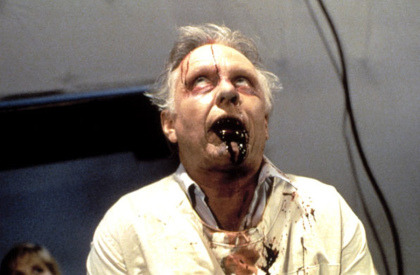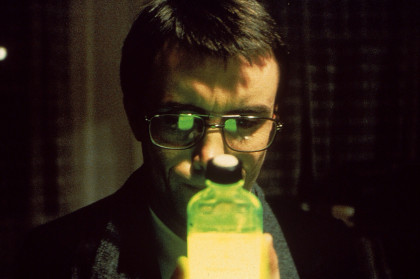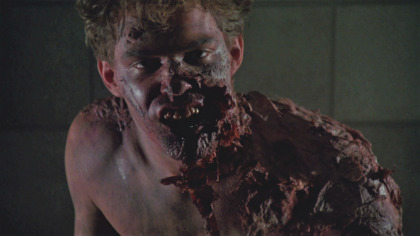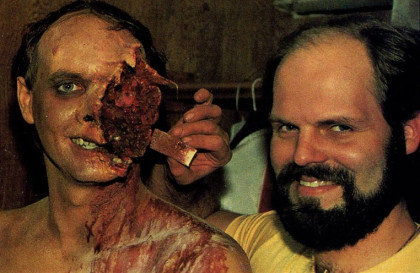#show/movie adaptations will always have to be fast tracked unless the book is just incredibly short
Explore tagged Tumblr posts
Text
SUMMARY At University of Zurich Institute of Medicine in Switzerland, Herbert West brings his dead professor, Dr. Hans Gruber, back to life. There are horrific side-effects, however; as West explains, the dosage was too large. When accused of killing Gruber, West counters: “I gave him life!”

West arrives at Miskatonic University in New England in order to further his studies as a medical student. He rents a room from fellow medical student Dan Cain and converts the building’s basement into his own personal laboratory. West demonstrates his reanimating reagent to Dan by reanimating Dan’s dead cat Rufus. Dan’s fiancée Megan Halsey, daughter of the medical school’s dean, walks in on this experiment and is horrified. Dan tries to tell the dean about West’s success in reanimating the dead cat, but the dean does not believe him. When Dan insists, the dean infers that Dan and West have gone mad. Barred from the school, West and Dan sneak into the morgue to test the reagent on a human subject in an attempt to prove that the reagent works, and thereby salvage their medical careers. The corpse they inject comes back to life, but in a frenetic and violent zombie-like state. Dr. Halsey stumbles upon the scene and, despite attempts by both West and Dan to save him, he gets killed by the reanimated corpse, which West then kills with a bone-saw. Unfazed by the violence and excited at the prospect of working with a freshly dead specimen, West injects Dr. Halsey’s body with his reanimating reagent. Dr. Halsey returns to life, also in a psychotic, zombie-like state. Megan chances upon the scene, and is nearly hysterical. Meanwhile, Dan collapses in shock.

Dr. Halsey’s colleague Dr. Carl Hill, a professor and researcher at the hospital, takes charge of Dr. Halsey, whom he puts in a padded observation cell adjacent to his office. He carries out a surgical operation on him, lobotomizing him. During the course of this operation, he discovers that Dr. Halsey is not sick, but dead and reanimated. Dr. Hill goes to West’s basement lab and attempts to blackmail him into surrendering his reagent and notes, hoping to take credit for West’s discovery. West offers to demonstrate the reagent and puts a few drops of it onto a microscope slide with dead cat tissue. As Dr. Hill peers through the microscope at this slide, West clobbers him from behind with a shovel, and then decapitates him, snarling “plagiarist!” as he drives the blade of the shovel through Dr. Hill’s neck. West then reanimates Dr. Hill’s head and body separately. While West is questioning Dr. Hill’s head and taking notes, Dr. Hill’s body sneaks up behind him and knocks him unconscious. The body carries the head back to Dr. Hill’s office, with West’s reagent and notes.

In his re-animated state, Dr. Hill acquires the ability to control other re-animated corpses telepathically, after conducting brain surgery on them. He then directs Dr. Halsey to snatch Megan away from Dan. While being carried to the morgue by her reanimated father, Megan faints. When she arrives, Dr. Hill strips her naked and straps her unconscious body to a table. She regains consciousness as Hill begins to sexually abuse her, including touching her breasts and placing his bloody severed head between her legs. West and Dan track Halsey to the morgue. West distracts Dr. Hill while Dan frees Megan. Dr. Hill reveals that he has reanimated and lobotomized several corpses from the morgue, rendering them susceptible to mind control as Halsey is. However, Megan’s voice reawakens a protectiveness in her father, who then fights off the other corpses long enough for Dan and Megan to escape. In the ensuing chaos, West injects Dr. Hill’s body with a lethal overdose of the reagent. Dr. Hill’s body mutates rapidly and attacks West, who screams out to Dan to save his work before being pulled away by Dr. Hill’s mutated entrails.

Dan retrieves the satchel containing West’s reagent and notes. As Dan and Megan flee the morgue, one of the reanimated corpses attacks and strangles Megan. Dan takes her to the hospital emergency room and tries to revive her, but she is quite dead. In despair, he injects her with West’s reagent. As the scene fades to black, Megan, apparently revived, can be heard screaming.
DEVELOPMENT When thinking of the sort of person who would have written a movie as bloody and outlandish as The Re-Animator, one might not immediately think of someone who teaches literature at a New York college but that’s exactly what screenwriter Dennis Paoli does for a living when not working on film scripts. Paoli has worked on and off with Re-Animator director Stuart Gordon since their high school days in Chicago, collaborating on projects that have ranged from comedy skits to a stage version of the hero epic Beowolf. By the time Gordon and William Norris contacted Paoli about the idea of collaborating on a Lovecraft script, Paoli’s academic pursuits had primed him for a venture into the bizarre.
youtube
Paoli says that he was originally brought onto the project as “the Gothic consultant,” because at the time he was working on his PHD in 18th and 19th century Gothic fiction. Paoli found that his knowledge of this style of literature could be applied to the task of adapting that latter-day Gothic H.P. Lovecraft. “The Gothics’ Paoli says, ” were the first kind of novels written. It’s very strange what’s happened to them. On the one hand, when you say Gothics you think of these current formula romances, but in their time, the first Gothics were the experimental novels. They would try anything to tell a story. They strove for effect, to have an immediate and violent effect on the reader. So they were banned in many places. In the House of Commons in England they called for a stop to romances, especially Gothic romances, because they were believed to be corruptive-just the same argument you get today.”
The Gothic-style source material for The Re-Animator was a series of six grisly stories by Lovecraft revolving around the mad scientist Herbert West. In a quest to conquer death, West concocts a serum that can re-animate dead bodies. The serum produces macabre results and West spends six stories refining his ghastly experiment.
This slideshow requires JavaScript.
At first The Re-Animator was envisioned as a series of 13 half-hour episodes to be produced for either syndicated or cable TV. Once an outline was drawn up, Paoli says that William Norris wrote the first half-hour pilot, but then the collaborators found that there seemed to be more interest in an hour show that might be included in an already existing anthology series. Paoli expanded the script to an hour, and then went on to expand it again to an hour and-a-half when prospects arose to produce the story as a feature film.
Adapting Lovecraft to create a violent, Gothic effect on screen has its problems, says Paoli, which may account for the mediocrity of previous Lovecraft films. One problem, says Paoli, is that most of the author’s stories were written in the first person; in the case of the Herbert West stories, the narrator is Dan Cain, West’s reluctant assistant. “Most movies,” explains Paoli, “aren’t made that way. It’s very difficult to get across the first-person point of view unless you use a lot of voice-over narration, but then that distances you from the screen. You don’t get that immediate effect”
Another problem concerns the nature of Lovecraft’s horror. “Lovecraft’s people have seen something that has changed them, that has twisted them, that has ruined their lives or made them mad. In the stories, all you get is the reactions to the horror. You do get some descriptions, actually some quite vivid descriptions, but they’re always made more vivid by your own imagination. On film, you have to show these horrifying things, these things that the narrators see which make them mad, and you’re under the obligation, in a way, to make your audience mad. That is an awful obligation for a filmmaker.” In the past this has been an area in which Lovecraft pictures have really fallen apart. Anyone who has been subjected to the endless psychedelic shots from the point of view of the monster in The Dunwich Horror can attest to that. In The Re-Animator, though, the graphic horror is displayed-in spades. “Because we have reached a period now where you can be explicit, it allowed us to show these bloody events without cutting away or suggesting them off-camera. You have to take that excessive route,” adds Paoli.
This slideshow requires JavaScript.
PRE-PRODUCTION Producer Brian Yuzna describes the original story and the way it was adapted to the screen. “H.P. Lovecraft’s story takes place at Miskatonic University at the turn of the century,” he says. “It has a very grisly, dark kind of feeling to it. The medical students there are digging up the dead and bringing the dead back to life. It goes on and on. It’s a kind of serial. These guys grow up and it just continues and continues.
The director selected for the project was Stuart Gordon, a theatrical director from Chicago who has written and produced some 25 plays including play versions of Sirens of Titan and Huckleberry Finn. He did a three-part science-fiction play to be performed on three consecutive nights, called Warp, which went on to Broadway and later became a comic book. He also directed the original version of the play E.R., which later became a television series starring Elliott Gould.
Yuzna describes Gordon as a “very talented guy and a real horror fanatic.” H.P. Lovecraft’s Re-Animator will mark his directorial film debut. Remarks Yuzna, “Stuart is such a talented director, though he had some trouble adapting to film because he really knew very little about the mechanics of filmmaking, but he’s an incredibly fast learner and he’s a very, very talented director of actors.” According to Yuzna, the production has aimed for “the sort of shock sensibility of an Evil Dead with the production values of, hopefully, The Howling.”
youtube
BEHIND THE SCENES/INTERVIEWS Robert Sampson, who plays Dean Halsey in the film, had some personal experience in what it’s like playing a zombie. He describes the film as “the most fun ! ever had going on to explain that it allowed him to indulge in the wildest fantasies I’ve ever had as a child, of scaring people, of doing all those things that I wasn’t allowed to see when I was a kid. I was not allowed to see the scary Frankenstein movies and all that stuff. My parents were afraid that it might do a number on me, so I would sneak out to go see them. And now I’ve had the opportunity to do one. I did a Twilight Zone and a One Step Beyond that were similar to this, but they weren’t as rich, as thought out.”
Halsey goes on to describe what happened when a corpse was injected with the re-agent. “They inject it at the base of the skull, and what it does is, it’s like sticking your finger in a light socket. You just go Ahhh! There isn’t any control. You turn into just this mad, re-animated thing.
“There’s a scene where I’m in a padded cell, and I have a strait jacket on, and my daughter doesn’t understand what’s happened to me. So she is standing there talking to this evil doctor standing behind this one-way mirror. It’s a mirror on my side and a window on his side, and he’s trying to seduce her. Heturns and looks and can’t find me at all. All of a sudden, I’m gone. But, as he’s making a move for her, I bang my head against the window. Now I don’t know why I’m doing this, but I still have a sense of feeling. The timing of it is so weird, because I just come up and bam!
“Stuart Gordon has this off-the-wall sense of humor that I didn’t even know was there until I went to see the first dailies. I was shocked by his macabre sense of humor, but it comes out of the reality of the situation. He has everybody playing it very serious, and the humor comes out of these seemingly normal people in this bizarre circumstances.”

“What this film is about is conquering death. I mean, Herbert West’s dream is something that all doctors have shared, and that is to prolong life as long as you possibly can. It used to be believed that when your heart stopped, you were dead. Now they have drugs like epinephrine which is an adrenaline derivative which can start the heart after it’s stopped. They use fibulators and electric shock to make the heart start again, so now the stopping of the heart does not necessarily mean you’re dead. Now what they’re calling death is defined as ‘brain death, which happens six to 12 minutes after the heart stops.
“West is trying to conquer brain death. What he is trying to do is prolong that six or 12 minutes as long as he possibly can so that a person who has died, even though their brain has never received any blood or oxygen, he can be brought back. His attitude is the same as any doctor’s, that it’s better to save a life even if it means the person is going to be debilitated, than to let the person die. Even if there is brain damage, it’s still better to have that person living than dead, so under that philosophy, his approach is medically correct.”
Gordon hopes that while watching these bizarre, bloody experiments, audiences will get involved with the film’s characters. “I’ve seen many horror films where you don’t care about anybody, and that to me sort of sinks the film. If you’re not afraid for someone, you’re not afraid. It’s important. I think that one of the things that we’ve really got going for us is that we really have some wonderful actors in this film who are giving spectacular performances. When things happen to them, I think the audience is going to really care, and they’re going to really feel bad about alot of it-and horrified.”

SPECIAL EFFECTS A tall order, to be sure, especially since the budget is estimated to be just under a million dollars, far less than most of the other competitors in the zombie-film field. But then, Yuzna expects Re-Animator to be an energetic film. Unlike most movie zombies, the living dead in this film are not slow, shambling creatures. The re-animating fluid Lovecraft imagined is a sort of super-adrenaline, and so the living dead are almost supercharged. In fact, one of the opening makeup effects, devised by John Buechler, is a Cronenbergian eye-popping caused by overdosing a corpse with too much of the serum.
youtube
While Buechler was called in to handle the exploding head, plus an articulated version of a re-animated decapitated noggin, and three special corpses in Dr. Hill’s zombie army, the main effects chores in the film were handled by Tony Doublin (mechanical) and John Naulin (makeup). Naulin has gone from managing the Shop of 1,000 Faces on the Universal Studios Tour to being manager of research and development at Don Post Studios for several years, and has since been teaching makeup and working on projects related to the entertainment industry including working on the Stilsuits for Dune. He headed a makeup crew which included Gerald Quist, John Criswell, Therese Shirley, Dana Ginzberg, Richard Davison, Jeff Seigal, Julie Manegers, Melonie Cleric and Richard McGuire.

Unlike the simple gray pallor that the undead have in many flicks, Re-Animator has some rather colorful zombies. John Naulin describes how this look came about. “Stuart, the director, had some disgusting shots brought out from the Cook County morgue of all kinds of different lividities and different corpses. We sat down with that and with a book of forsenic pathology, and picked about eight or nine special colors that are not normally available with the makeups that we were using, and we had the makeup lab mix up some custom colors for us,” he said. “The corpses in this film will reflect how a corpse actually looks once the blood has settled in the body.” (After death, gravity causes blood to pool in the lowest portions of the body which in turn creates a variety of odd skin tones.)
When we ask Naulin how he would describe the effects in this film, he replies, “Moist. This is the bloodiest film 1 have ever worked on. I’ve been mixing up the blood on this film, and in the past I don’t think I ever used more than a couple of gallons of blood on a single film, but on this one, when we’re done, we’ll have used 24 gallons.
“So far the stuff looks real good. We had some of our crewmembers that couldn’t make it through some of the screenings, let’s put it that way. What especially got them was the scene where David Gale, who plays the zombiefied Dr. Hill, gets his head cut off with a shovel. I don’t think this has ever been done where somebody, on camera, has a shovel shoved through a live actor’s head and there’s a live body that is still moving and kicking, and then the head rolls off, and it’s still moving.”

The headless Dr. Hill zombie was the biggest challenge in the film. Explains Naulin, “Most times somebody loses their head in a film, you see maybe a 100 frames of it and it’s gone. We’ve got to carry 50 pages of it.” The effect was achieved a number of ways, most of which were designed by Tony Doublin. Doublin explains that the problem wasn’t “so much the body being headless, but the fact that you always run into the problem of what you do with the nine or 10 inches you lose when you lose somebody’s head. If you go up with the shoulders, the crotch and the arms become all distorted, and all the proportions go to hell. I’d seen The Dark where this guy’s head was pulled off, and it looked like a midget in a fiberglass body, but it didn’t stumble around quite as badly. Each scene we had to use a different technique! One technique that proved quite effective was building an upper torso that an actor could bend over and stick his head through so that his head appeared to be the head that the walking corpse was carrying around.
To keep Hill’s head alive, it frequently sits in a pan of blood to get its blood supply replenished. This required numerous scenes where David Gale had to sit with his head sticking up into a bloody pan while blood dribbled down the cracks in the opening. While this effect proved simple to do, it was quite un comfortable for the actor. Well, nobody said Hollywood was all glamour.
youtube
The big climax necessitated the most work. The various undead in Dr. Hill’s zombie army had to be made up, plus effects rigged not only for Dr. Hill, but also exploding veins (caused by an overdose of the serum) and burn effects. In addition, there were Buechler’s three special corpses: one of a motorcycle accident victim who looked like he skid for awhile; a failed operation that had been stuck in a body bag without the doctors bothering to remove the hospital tubes or put his guts back into his abdomen; and a third corpse, nicknamed “Gesundheit,” which was supposedly the victim of a close range shotgun blast at the back of his head which blew off the front of his face and left a gaping orifice which has hardened and dried.
This slideshow requires JavaScript.
CAST/CREW Directed Stuart Gordon
Produced Brian Yuzna
Screenplay Dennis Paoli William J. Norris Stuart Gordon
Based on “Herbert West–Reanimator” by H. P. Lovecraft
Jeffrey Combs as Herbert West Bruce Abbott as Dan Cain Barbara Crampton as Megan Halsey David Gale as Dr. Carl Hill Robert Sampson as Dean Alan Halsey Al Berry as Dr. Hans Gruber Carolyn Purdy-Gordon as Dr. Harrod Ian Patrick Williams as the Swiss Professor Gerry Black as Mace Peter Kent as Melvin the Re-Animated Craig Reed as the One Arm Man Corpse a.k.a. the Burn Victim
CREDITS/REFERENCES/SOURCES/BIBLIOGRAPHY Fangoria#61 Fangoria#46 Fangoria#50 Delirium#01 Cinefantastique v15n04
Re-Animator (1985) Retrospective SUMMARY At University of Zurich Institute of Medicine in Switzerland, Herbert West brings his dead professor, Dr.
1 note
·
View note